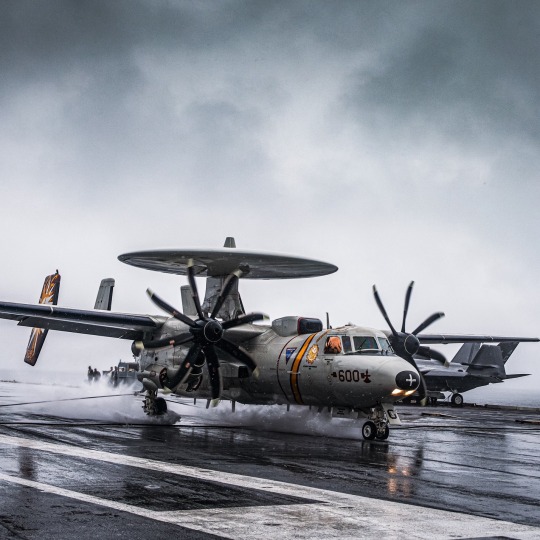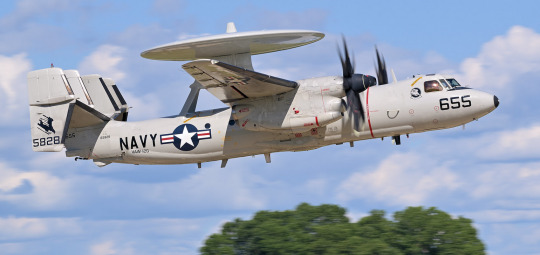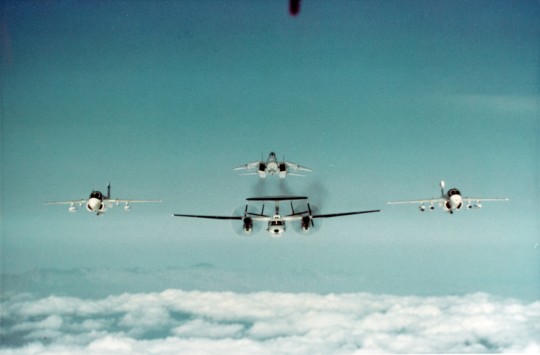#e 2c Hawkeye
Text

A U.S. Navy E-2C Hawkeye from Elvis’ SUN KINGS landing on the USS George Washington in some heavy weather on 11 May 2024. (clawson)
@kadonkey via X
194 notes
·
View notes
Text

🔴E-2C Hawkeye Land On Nimitz-Class Aircraft Carrier
PACIFIC OCEAN (Aug. 7, 2007) - An E-2C Hawkeye, attached to the squot; Golden Hawks squot; of Carrier Airborne Early Warning Squadron (VAW) 112, lands on the flight deck of the Nimitz-class aircraft carrier USS John C. Stennis (CVN 74) after completing a training mission as part of exercise Valiant Shield 2007. The John C. Stennis, Kitty Hawk and Nimitz Carrier Strike Groups are participating in Valiant Shield 2007, the largest joint exercise in recent history. Held in the Guam operating area, the exercise includes 30 ships, more than 280 aircraft and more than 20,000 service members from the Navy, Air Force, Marine Corps, and Coast Guard. U.S. Navy photo by Mass Communication Specialist 3rd Class Jon Hyde
#military#aircraft#air force#us air force#usaf#fighter jet#aviation#fighter plane#plane#us navy#us marines#E-2C Hawkeye#aircraft carrier#aviation photography#aviation history#military aviation#pacific ocean#USS John C. Stennis#CVN 74#Nimitz-class#kitty hawk#Nimitz Carrier Strike Groups
33 notes
·
View notes
Text

US Navy showing off their E-2C at Oshkosh
58 notes
·
View notes
Photo

An E-2C Hawkeye aircraft passes overhead as a Fighter Squadron 84 (VF-84) F-14A Tomcat aircraft stands by for launch on the flight deck of the nuclear-powered aircraft carrier USS Abraham Lincoln (CVN-72) during the ship's shakedown cruise. 1990
74 notes
·
View notes
Text

(10/25/1992) A formation of aircraft assigned to the nuclear-powered aircraft carrier USS GEORGE WASHINGTON (CVN-73) flies over the ship. The aircraft are an E-2C Hawkeye, an EA-6B Prowler, an A-6E Intruder, an S-3 Viking, two F/A-18C Hornets and two F-14 Tomcats USN CMDR. John Leenhouts Nara Image
79 notes
·
View notes
Text

How many planes did the USS Nimitz carry?
The USS Nimitz (CVN-68) is a large and advanced aircraft carrier that can hold 60-80 aircraft on its flight deck, depending on size and type. The ship typically carries: 10-15 fighter jets (F/A-18E/F Super Hornets), 10-15 attack aircraft (AV-8B Harriers), 2 early warning aircraft (E-2C Hawkeyes), 4 tanker aircraft (KC-130Q/J/K/RF Cornbread tankers), and 10-15 helicopters (SH-60F/R Seahawks, MH-60R/S Seahawks, or CH-53E Super Stallions). In total, the ship can carry around 50-70 aircraft at a time, although this number may vary depending on mission requirements and aircraft types.
74 notes
·
View notes
Text
One of the funnier things in life is knowing Parks Stephenson, executive director of the USS Kidd Museum, E-2C Hawkeye controller veteran with 20 years in the Navy, found the USS Johnston and USS Samuel B. Roberts, five time expedition veteran to the RMS Titanic, is a fucking massive kancolle fan to the degree of trying to get an official collab going between the Kidd Museum with KanColle
423 notes
·
View notes
Text
Footage released by USCENTCOM showing US Navy F/A-18E/F Super Hornets, EA-18G Growlers, and an E-2C Hawkeye launching from the USS Eisenhower to conduct strikes on Houthi targets in Yemen this evening. 22 Jan 2024
#modern#combat footage#aviation#2023 israel-gaza conflict#arab-israeli conflict#yemeni civil war#operation prosperity guardian
26 notes
·
View notes
Text

"Leads a group of Grumman-manufactured first-line Navy aircraft in formation. At top is an F-14 Tomacat fighter. An E-2C Hawkeye AEW aircraft on the bottom, A-6E Intruder attack plane is at left, and an EA-6B Prowler ECM plane is at right."
Naval History and Heritage Command: K-116900
#Grumman F-14 Tomcat#Grumman F-14#F-14 Tomcat#F-14#Tomcat#Grumman#Fighter#Grumman E-2 Hawkeye#E-2#AEW aircraft#Grumman A-6 Intruder#A-6#Attack Aircraft#Grumman EA-6 Prowler#EA-6#ECM Aircraft#United States Navy#U.S. Navy#US Navy#USN#Navy
15 notes
·
View notes
Video
Navy E-2C Hawkeye, VAW-120, #165812 (2) by Michael DeBock
9 notes
·
View notes
Text
Aircraft Carriers: Powerhouses of Modern Navies - A Deep Dive into Nimitz-Class, Queen Elizabeth-Class, and Global Carrier Fleets
Introduction to Aircraft Carriers
Aircraft carriers are monumental warships that serve as mobile airbases, enabling nations to project power far beyond their shores. They provide a platform for launching and recovering aircraft, which can perform a variety of roles, including air superiority, ground attack, anti-submarine warfare, and reconnaissance. These capabilities make aircraft carriers critical assets in modern naval strategy, allowing countries to exert influence over vast maritime regions, respond quickly to crises, and support global military operations.

Nimitz-Class Aircraft Carriers
The Nimitz-class carriers are a class of ten nuclear-powered aircraft carriers in service with the United States Navy. Named after Fleet Admiral Chester W. Nimitz, a key figure in the Pacific theater during World War II, these carriers have been the backbone of the U.S. Navy's carrier fleet since their introduction in the 1970s.
Design and Specifications: Nimitz-class carriers are among the largest warships in the world, each displacing around 100,000 tons. They measure approximately 1,092 feet in length and have a beam of 252 feet. Powered by two nuclear reactors, these carriers have a virtually unlimited range and can operate for over 20 years without refueling, providing sustained presence and flexibility.
Capabilities: The Nimitz-class carriers can accommodate about 90 aircraft, including F/A-18 Hornets, EA-18G Growlers, E-2C Hawkeyes, and MH-60R/S helicopters. The flight deck is equipped with four steam catapults, enabling rapid launch and recovery of aircraft. Advanced radar systems, electronic warfare capabilities, and missile defenses protect the carrier from various threats, ensuring it can operate effectively in contested environments.
Role and Deployment: Nimitz-class carriers have been deployed globally, participating in combat operations, humanitarian missions, and training exercises. They play a crucial role in projecting U.S. power, providing a credible deterrent, and supporting allies. Notable deployments include operations in the Persian Gulf, where they have supported combat missions in Iraq and Afghanistan, and disaster relief efforts in Southeast Asia.
Queen Elizabeth-Class Aircraft Carriers
The Queen Elizabeth-class carriers mark the Royal Navy's return to operating large aircraft carriers. This class comprises two ships: HMS Queen Elizabeth and HMS Prince of Wales. These carriers are the largest and most advanced warships ever built for the Royal Navy.
Design and Specifications: Each carrier displaces around 65,000 tons and measures 920 feet in length. They are conventionally powered, utilizing integrated electric propulsion systems. The design features twin islands, which improve command and control, and a ski-jump ramp for short take-off and vertical landing (STOVL) operations. The flight deck is capable of accommodating up to 40 aircraft.
Capabilities: The Queen Elizabeth-class carriers are designed primarily to operate the F-35B Lightning II, a fifth-generation multirole stealth fighter capable of STOVL operations. They can also deploy various helicopters, including the Merlin for anti-submarine warfare and airborne early warning, as well as Chinooks for troop transport. These carriers are equipped with advanced radar and self-defense systems, ensuring they can operate in high-threat environments.
Role and Deployment: These carriers enhance the UK's ability to project power globally. HMS Queen Elizabeth has already completed her maiden operational deployment, integrating with NATO allies and participating in multinational exercises in the Mediterranean, Indian Ocean, and the Pacific. The Queen Elizabeth-class carriers are expected to be central to the UK's defense strategy, providing rapid response capabilities and supporting international security efforts.
Aircraft Carriers by Country
Aircraft carriers are a potent symbol of naval power, and several nations operate or are developing carriers to bolster their strategic capabilities.
United States: The U.S. Navy operates 11 aircraft carriers, including the Nimitz-class and the new Ford-class, which will eventually replace the older Nimitz-class ships. These carriers form the core of the U.S. Navy's blue-water capabilities, ensuring global reach and influence. The Ford-class carriers introduce advanced technologies, including electromagnetic catapults and improved nuclear reactors, enhancing operational efficiency and combat capability.
United Kingdom: The Royal Navy operates two Queen Elizabeth-class carriers, which restore its ability to conduct carrier strike operations. These carriers are pivotal to the UK's defense strategy, enabling rapid response to crises and supporting global security efforts. Their integration with F-35B aircraft and advanced support systems enhances their operational versatility and effectiveness.
France: The French Navy operates the Charles de Gaulle, a nuclear-powered aircraft carrier. Commissioned in 2001, it supports a range of operations, from air superiority to anti-submarine warfare. The Charles de Gaulle has been deployed in various missions, including combat operations in the Middle East and humanitarian relief efforts. France plans to develop a new-generation carrier to replace it by the late 2030s, ensuring continued carrier capability.
China: China has been rapidly expanding its carrier capabilities, with two carriers currently in service: Liaoning (a refitted Soviet-era carrier) and Shandong (an indigenous design). A third, more advanced carrier, the Type 003, is under construction. These carriers signify China's growing naval ambitions and its desire to project power in the Asia-Pacific region. They support China's strategy of securing its maritime interests and extending its influence.
India: The Indian Navy operates INS Vikramaditya, a modified Kiev-class carrier, and is building its first indigenous carrier, INS Vikrant. These carriers are crucial for India's strategic presence in the Indian Ocean and beyond. They enhance India's ability to project power, support regional stability, and respond to maritime threats.
Russia: Russia's carrier capability is currently limited to the Admiral Kuznetsov, a vessel that has faced numerous technical challenges and is undergoing a lengthy refit. While Russia has plans to develop new carriers, financial and technical hurdles have delayed progress. Despite these challenges, Russia continues to prioritize carrier development as part of its broader naval modernization efforts.
Other Countries: Several other nations, including Italy, Spain, and Japan, operate smaller carriers or amphibious assault ships capable of launching fixed-wing aircraft. These platforms enhance their regional capabilities and support international operations. For instance, Japan's Izumo-class ships are being modified to operate F-35B aircraft, reflecting a strategic shift towards increased carrier capability.
Conclusion

Aircraft carriers by country remain a central component of modern naval strategy, offering unmatched versatility and power projection. The Nimitz-class and Queen Elizabeth-class carriers exemplify the pinnacle of carrier design and capability, each serving their respective nations' strategic needs. As more countries seek to develop or expand their carrier capabilities, the global naval landscape continues to evolve, underscoring the enduring importance of these formidable vessels. Whether through deterrence, humanitarian aid, or combat operations, aircraft carriers will continue to shape the future of naval warfare.
0 notes
Text

2 e-2 Hawkeyes coming into land to the depot, with one having no radar dome
@Wavy_zyro via X

33 notes
·
View notes
Text
DOD Featured Photos
Strength Struggle
Marine Corps Col. Sean Dynan, right, leads his team in a friendly tug of war with U.S. and Indonesia… Photo Details >
Hawkeye Watch
An E-2C Hawkeye lands on the flight deck of the aircraft carrier USS George Washington while underwa… Photo Details >
Horse Sense
A horse belonging to the Marine Corps Mounted Color Guard eyes the camera at the Pimlico Race Course… Photo Details…

View On WordPress
0 notes
Photo

VAW 117 E-2C Hawkeyes off the Channel Islands coast
#US Navy#Aviation#Aircraft#Northrop#Grumman#E-2#Hakeye#AEW Aircraft#VAW-117#Airborne early warning#Channel Islands
55 notes
·
View notes
Text
US Navy Northrop Grumman E-2c Hawkeye Of Carrier Airborne Early Warning Squadron 115 Vaw-115, Liberty Bells Hawaiian Shirt For Men And Women
The US Navy Northrop Grumman E-2c Hawkeye of Carrier Airborne Early Warning Squadron 115 Vaw-115 is a surface-based air warning and control squadron. It is based in Honolulu, Hawaii, and consists of the Liberty Bells Hawaiian Shirt for Men and Women, which is designed to keep you and your hands free for essential tasks. The shirt features a colorful
Get it here : US Navy Northrop Grumman E-2c Hawkeye Of Carrier Airborne Early Warning Squadron 115 Vaw-115, Liberty Bells Hawaiian Shirt For Men And Women
Home Page : tshirtslowprice.com

1 note
·
View note

